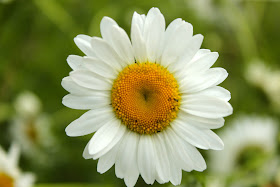Now that the summer wildflowers are blooming fast and furious, I realize I could quickly overwhelm both you and myself if I try to cover them all, so I've decided to try to stick to a theme each week.
This week we're going to look at some flowers that are sometimes confused with dandelions. These are flowers that grow in fields and sunny places, like my lawn. Just as Z, E, and I were on our way out the door to go to the Fiber Frolic on Saturday, C started cutting the grass. I grabbed my camera and ran ahead of the mower, snapping pictures before the flowers got gobbled up in its maw.
The common dandelion (Taraxacum official) has passed its heyday around here. There are a still a few lingering here and there, but nothing like the yellow-dotted lawns and fields of a few weeks ago.
Dandelions are members of the composite or aster (Asteraceae) family. These "flowers" are actually inflorescences, or clusters of many flowers that look like a single bloom. They may be made up of all ray flowers, like the dandelion, all disk flowers, or a combination of ray and disk flowers, like the ox-eye daisy (Leucanthemum vulgare).
Several flowers that bloom throughout the summer have a similar appearance to dandelions--low growth, bright yellow inflorescences made up of all or mostly ray flowers. The first of these to appear, soon after the snow melts, is coltsfoot (Tussilago farfara). By now, these little flowers have released their tufts of seeds to the wind and been replaced by leaves the size and shape of horses' hooves. These flowers' early appearance, the presence of disk in addition to ray flowers, and the very different leaves (which appear after the flowers have passed), distinguish coltsfoot from dandelion.
Just starting to open up now are the hawkweeds. This is yellow hawkweed (Hieracium caespitosum). Hawkweeds are taller than dandelions and have fuzzy stems and leaves, while the dandelion's stem is smooth, almost sticky, and the leaves are also smooth-surfaced, and sharply toothed. The inflorescences also grow in clusters at the top of the stem (while dandelions produce a single bloom per stem).

No one would mistake an orange hawkweed (Hieracium aurantiacum) for a dandelion, but it's so pretty, I had to include it here.
It also has many fewer, but larger, rays than a dandelion.
A few other dandelion-like yellow composite flowers will make their appearance in the Northeast over the summer. If you're wondering whether a flower head you see is a dandelion, look for flower type (all rays or rays and disks?), leaf shape and texture, and season of growth. Either way, bright yellow flowers are cheerful companions on a summer's day.
P.S. My lady's slippers are still going strong in the woods, which makes me really happy. I also learned quite a few new woodland flowers on a birdwatching expedition a couple hours northwest of here Sunday. I didn't have my camera with me (camera plus binoculars is too much) and didn't even take pictures with my phone (sometimes it's nice to take a break from documenting), but I'll be keeping my eyes out for those flowers to appear around here.
My main source for keying out wildflowers is Newcomb's Wildflower Guide. But because Newcomb's is out of date, I use GoBotany to cross-reference the Latin names (and also compare to photographs if I'm unsure of the plant's ID).






Great post, Andrea!
ReplyDeleteYay about the lady slippers! I still have not seen one open here.
Thanks, Dawn! You should be getting lady's slippers any minute now.
DeleteInteresting. None of those flowers would fool me, but there are some very dandelion-like greens with dandelion-like fluff that grow all over my yard and one time heard a master gardener say that a lot of what grows locally here is a mimic so now I do not know which ones to eat.
ReplyDeleteHmm...I don't know what those might be. Share a picture sometime and maybe we can sleuth it out!
DeleteWe found all of those in the woods today, well except for the coltsfoot :) Little man loves the hawkweed, and I am lucky enough to have a little vase of them on my kitchen counter, both orange, and yellow.
ReplyDeleteThe other one we found today, similar to dandelion was cynthia (orange/yellow).
Enjoy your wildflower adventures.
Aww, did he pick the hawkweed for you? I should have picked ours before they got mowed down!
Deleteit's wonderful how many there are.
ReplyDeletei have always used dandelion leaves in cooking..
I used to cook with dandelion greens, but the last couple of times I've had a mild respiratory reaction, so I stay away from them now. :(
Delete